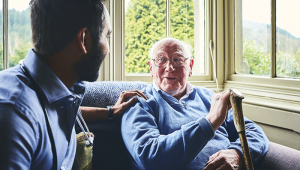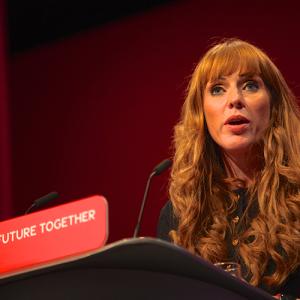Austerity, or rather the cocktail of factors that cause it, doesn’t seem to be going away anytime soon. In fact permanently less money, growing demand, an exponential rise in expectations and a form of hyper-scepticism about public institutions and their ability to do anything good (at all) feels like the new normal. Our task, whether we like it or not, is to figure out how to survive and thrive in this world, a world as it is and not how we would like it to be. This calls for a strategic response that is not about weathering the storm, but about adapting to a world that is always wetter, windier and colder.
In my borough two big pieces of work have helped us navigate and then frame our response. One has been an independently led growth commission. Reporting last year and entitled No one left behind - in pursuit of growth for the benefit of everyone it made recommendations about how we could maximise economic opportunities for all. The other has been a fundamental review of our council’s operating model which looked at how to sustainably transform services so that amongst other things they help support people to live independently and sustainably for as long as possible without the on-going intervention of the state in their lives. All of this has meant taking an unashamedly long-term view – a 20-year manifesto for the borough – liberating ourselves from the immediate constraints of the here and now and instead really challenging the art of the possible. By way of inspiration, I often say to staff, though we may not have chosen it, it falls to our generation of public servants to define what public services will be about in the mid to late 21st century.
Thinking differently has been absolutely essential to understanding how we might achieve our ambitions for local people and our aims to reduce demand and make savings. We aim to take £47m out of our budget by 2020 without service reductions. Central to our approach is this question: what’s really pivotal to a resident’s situation when they ask us for help? Our theory of change is that if we design our services and interventions according to the answers we have a much better chance of making a long-term sustainable impact on their lives. It led to the realisation that we’d need to ask a different set of questions that gets below the surface and then fundamentally redesign services so that their starting point is always to focus on what is pivotal, rather than meeting the presenting need. It’s for this reason that, while the temptation to cut policy, insight, behaviour change and communications resources is high, we have doubled down and invested more.
Here’s an example of our thinking and how it’s influenced the new structure and purpose of our organisation. Previously, if a resident believed they were at risk of becoming homeless, we would direct them to our homeless service, based in our housing department. Our response, inevitably, would focus on accommodation. The question we would have asked would be something like, “how are we obligated to help you find somewhere to live?” Sounds right? But we’ve made a massive assumption that the pivotal need is addressed through bricks and mortar.
The new question our integrated and co-ordinated Community Solutions team will be asking from of the spring of 2017 is: why are you homeless? Evidence shows it could be for a variety of reasons. It might be that you can’t afford the rent. Or in our borough it’s often due to cases of domestic violence. If that’s the cause of the issue, the solution might well be very different to our traditional approach. The new team will have the right people in place to help resolve it. More to the point, our teams will be looking to identify solutions that exist within the community already or indeed within the gift of the individual resident or family in question to find and develop from within themselves.
We are designing in community solutions. Today if someone with a child with Asperger syndrome looked at our website for support they would most likely come to a link explaining the process to apply for a Special Educational Needs Statement. While this might be an important part of the jigsaw of support, is it the most helpful first response? It’s an approach that prioritises our role as gatekeeper rather than that of convener of a range of community-based support and self-help that might be more appropriate. Connecting one parent to another parent to share experiences, off load, share a tear or two, and provide mutual day-to-day support may be the pivotal intervention that makes all the difference, so why don’t we offer that first? .
We’re after a win-win of course, and we’re not putting all our financial eggs in this basket. We expect our new approach to generate modest and bankable savings of £5m per year by 2020. It will help us learn and prove the concept and already in the testing phase staff are more efficient and enthused. Time spent running between different departments, or gathering for case conferences is reducing.
Similarly, we’ve asked fundamental questions about how we grow our income base and make the most of what’s key to our economy: lots of space and access to London. Underneath that question was another one about how to build in income generation from the start. So we’re setting up a wholly owned development and investment company that our planning and regeneration functions will be transferred into.
What was pivotal in this case was the need for pace, scale and the ability to handle large investment portfolios and income returns. So we’re giving it the capacity, through the use of fees for example, to be able to handle the business of delivering 2,500 new homes a year (as opposed to 600 a year currently.) The target for the new company is to return £15m a year to the medium term financial strategy by 2020.
I often use a technology metaphor to explain the leap we need to make. In 2006 we used to walk around with (for example only other brands are available): a Nokia phone, a wallet, maybe an Olympus digital camera and an iPod. Don’t get me wrong I loved my iPod but when the first smartphones arrived, our ability to interact with other and consume media changed forever. By today’s standards even those first devices feel dated and clunky. The vision for our council I describe to staff stakeholders of course is the public service equivalent of an iPhone 7 or the latest Samsung Galaxy, in all their complexity, form and beauty, but viewed from the perspective of 2006.
It’s unashamedly pitched to be compelling but with that comes the risk of a vision that could also feel fantastical and unobtainable. For this reason, our new council starts to take form in in 2017-18 as a prototype iPhone 1 with glitches and a poor battery life to boot. But from this platform we hope to spark a consumer revolution both inside the council and out similar to that provoked by those first connected and intuitive gadgets launched a decade ago. We don't know for certain where this will take us – but then who would have predicted the power and influence of Twitter, Snapchat and Facebook, all applications designed by and for a community but impossible to imagine without the platform of a smartphone?
It's a different way of thinking for sure, and not without its challenges. But it’s exciting and we believe we’re onto something good.
Read PF's 2015 interview with Chris Naylor here
This article is part of the CIPFA Voices series




















